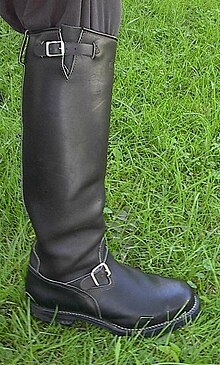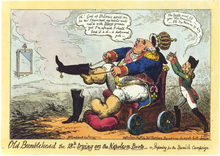Boots
The boot is a basic shoe shape and therefore represents a type of footwear. Compared to the low shoe , which only extends to the crook of the foot, a boot is a shoe whose shaft (technically speaking for the upper part of the shoe, as distinct from the shoe bottom ) extends at least above the ankle. The boot shaft is again roughly subdivided into the foot part and the adjoining pipe that extends upwards (commonly known as the “shaft”).
Technical definition and demarcation
In the technical sense, shoes with a minimum shaft height (measured at the rear edge between the upper edge of the heel and the upper edge of the shaft) of 80% of the shoe length in question are called boots or boots .
If it is an ankle-high boot (lace-up boot, slip-on boot with elastic insert or with a zipper), one also speaks of an ankle boot . The design (= manufacturing-related design of the connection between the upper and the sole), different soles and heel heights are irrelevant. In the narrower sense, an ankle boot is an elegant boot which, thanks to an elastic insert on the side of the shaft, makes it easier to slip and holds the boot on the foot.
From boots Sandals is when the straps of sandals reach up to above the ankle.
Categorization
Boots can be differentiated according to various criteria:
- Shaft length (boots / boots and ankle boots, half- shaft boots, long- shaft boots, over-the-knee boots)
- Use (for example, motorcycle boots , riding boots , ice skate boots , hunting boots , ski boots , hiking boots , Western boots , combat boots , march boots , combat boots , safety boots , waders )
- Shape of the shaft (e.g. crop cut, side section cut, gauntlet boots )
- Material (for example, rubber boots , leather boots , patent boots , wood boots , Filzstiefel and Fellstiefel )
Models
Women's and men's models often only differ in the shape of the lasts and heel height (although men's boots with higher heels can occasionally be seen at fashion shows. However, such designs have so far not caught on in retail and in everyday fashion). In the 19th century there were many boot models ( Hessen boots , Wellington boots , Bottine , Jacobin boots and so on), but most of them have survived. Today, fewer models that differ from one another based on the shaft cut are differentiated.
In the classic men's shoe sector, the following over-ankle-high models have remained unchanged for decades:
- With a usually comparatively low shaft: the Chelsea boot (with an elastic elastic band on the side), Jodhpur boots (with a strap with a pin buckle around the joint), George boot and Chukka boot (both lace-up shoes; the George boot is clearly enough higher), ring trimmed boots or also called Balmoral (with so-called closed lacing and eye-catching shaft cut) and the derby boot (sporty "boot" with so-called open lacing).
- The following models usually have a higher shaft: engineering boots (with a strongly rounded toe and a marching strap (foot protector) over the instep, usually reaching just above the middle of the calf), western boots (tapering to the front, mostly with sewn-on decorations and a shaft tube up to the middle of the calf) and motorcycle boots or biker boots (with abrasion-resistant soles, the shaft that protects the leg from engine / exhaust heat and abrasions in the event of a fall, and a mostly round or at least not narrow toe). Finally there is the riding boot , the characteristics of which are a simple, slim, high shaft and usually a fine sole.
Historical and today's meaning / use
The oldest evidence of boots can be seen on the wall paintings (15,000–13,000 BC) in the Spanish Altamira cave . There hunters are shown wearing boot-like clothing. Even back then, the boot served as additional mechanical and thermal leg protection compared to the low shoe. In this respect, boots can be found traditionally and for a specific purpose among soldiers ( riot beakers and combat boots , parachute jumper boots) and hikers, mountaineers, hunters and as footwear for certain sports (ski boots, boxing boots, etc.), as well as safety boots in professional use (firefighters, forest workers). In addition to the fashion-related boots, boots can also be found as footwear tied to certain tasks. Thus, for example, the riding boots are worn for riding and the rubber boots are worn for washing cars or the like .
After the boots - and especially the models with a high shaft - became an increasingly rare phenomenon as everyday footwear by the end of the First World War at the latest (the protective function of the boot was hardly needed, and low shoes are cheaper and mostly more comfortable), it has been since Middle of the 20th century for both sexes strongly fashion-dependent. There is a greater variety of different boot models and shaft tube heights for women.
particularities
Depending on the model, boots have some special features compared to low shoes. In order to fit well and thus enable comfortable walking, a boot must lie close to the instep and consequently be correspondingly tight at this point. Boots without a lace, zip or strap fastener (so-called slip -on boots ) and with a high boot tube can only be put on and taken off without problems if this point is sufficiently wide so that the foot can slip around the bend. Alternatively, as is often the case with women's boots, the shaft can consist of a thin, stretchable material.
If a comfortable slip-in is to be ensured, the shaft no longer lies close to the crook of the foot, so that the foot lifts up when walking. To prevent this, the foot is a march belt pulled (an adjustable with a buckle in the length of belt which is fixed in the shoe bottom and extends transversely over the instep) fixed in the heel region of the boot.
Since boots are difficult to put on for these reasons, many models have so-called "pull loops" sewn into the upper inner edge of the shaft. Pulling these loops of fabric tape with your fingers while pressing your foot into the boot makes it easier to put on. This is facilitated by a so-called boot pull hook: a hook is inserted into the pull loop and the whole hand pulls on the wooden handle at the other end.
To make it easier to take off the boot, a so-called boot jack is used. The name goes back to a servant who used to help the boot wearer take off. Today it is a wooden board - set up at an angle and cut out in a U-shape at one end. The boot heel is inserted into the neckline; the boot can be pulled off the foot by applying counter pressure with the other foot on the board.
Ankle-high lace-up boots, as they are classic men's shoes, have eyelets in the lower area of the lacing and - for easier putting on and taking off - hooks (agraffes) in the upper area; so also the derby boot pictured at the beginning.
Meaning in eroticism
Boots can create erotic associations in some people. This applies to certain, mostly high-heeled women's boot models more than to other boots. For example, long shaft boots that reach above the knee, also called overknees or thigh highs , mostly with uppers made of patent leather or latex , with platform soles and / or high heels , especially in the BDSM scene, are considered fetish objects .
heraldry
In heraldry , the boot, as well as the shoe as a heraldic figure , is one of the common figures .
- Main entry: shoe and boots
Influence on language
In the German-speaking area there are a few idioms that refer to boots:
- "So (or vice versa ) is a boot therefrom." (It is So / reversed right.)
- " Don't talk (or: tell ) such a boot!" (Don't talk such nonsense!)
- "It can take a good boot." (It is very hard-drinking.)
In the English language, many everyday words come from the word for boots. Expressions such as bootstrap loader , bootleg and bootcut fall into this category , some of which have also found their way into everyday German as loan words (bootleg, " rebooting the computer" etc.)
Boots in literature
The boot is a common motif in folk tales and stories:
-
Brothers Grimm : The Buffalo Leather Boots , Wikisource

-
Brothers Grimm : Puss In Boots , Wikisource

- Johann Wilhelm Wolf : The iron boots (from: Hausmärchen ), zeno.org
- anonymous: Count Walerant's half-pulled boots (from France, German translation: Alfred Semerau , 1907)
- Georg Queri : The purrs of Rochus Mang - The boots of Messner Hans in the Gutenberg-DE project
- anonymous: Legends from the Hanseatic League - The devil's boots in the Gutenberg-DE project
- The motif of the seven-league boots can be found in several fairy tales and stories .
literature
- Tyler Beard: Cowboy Boots , Gibbs Smith, 2004, ISBN 1-58685-522-0 (English).
- Valerie Steele: Shoes , duMont, Cologne 1999 (Original title: Shoes - A Lexicon of Style , Co. & Bear Productions (UK) Ltd., 1998, translated by Wolfgang Himmelberg). ISBN 3-7701-8523-4 .
- Helge Sternke: Everything about men's shoes. Nicolai, Berlin 2006, ISBN 3-89479-252-3 .
See also
Balmoral , Chelsea boot , George boot , Jodhpur boots , combat boots , top boots , Comrade Lace , shoes , shoe fetishism , Stiefelknecht , switching amplification , Puss in Boots




